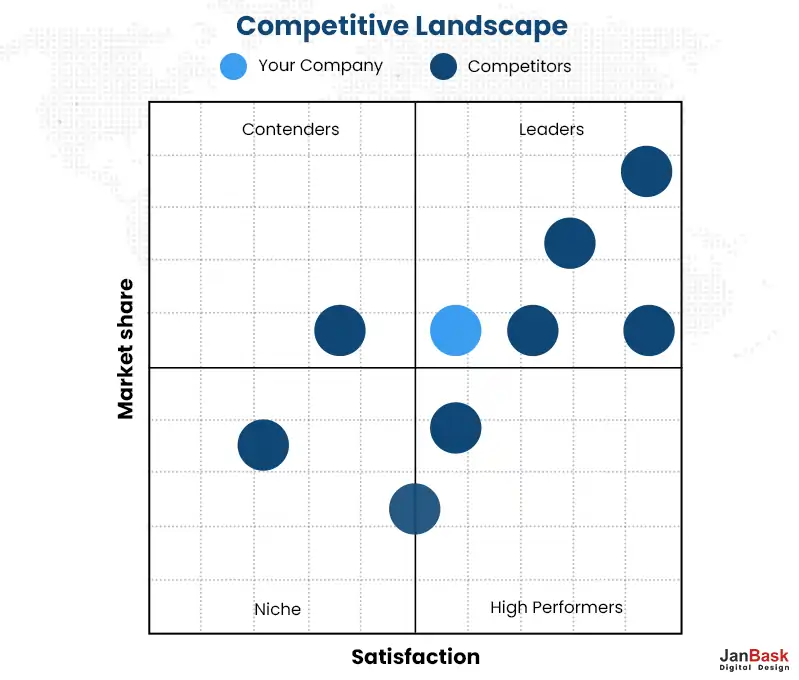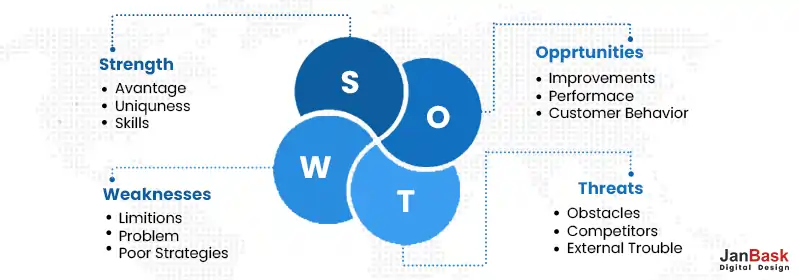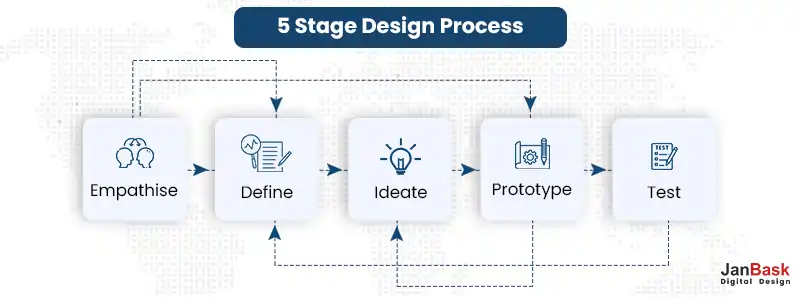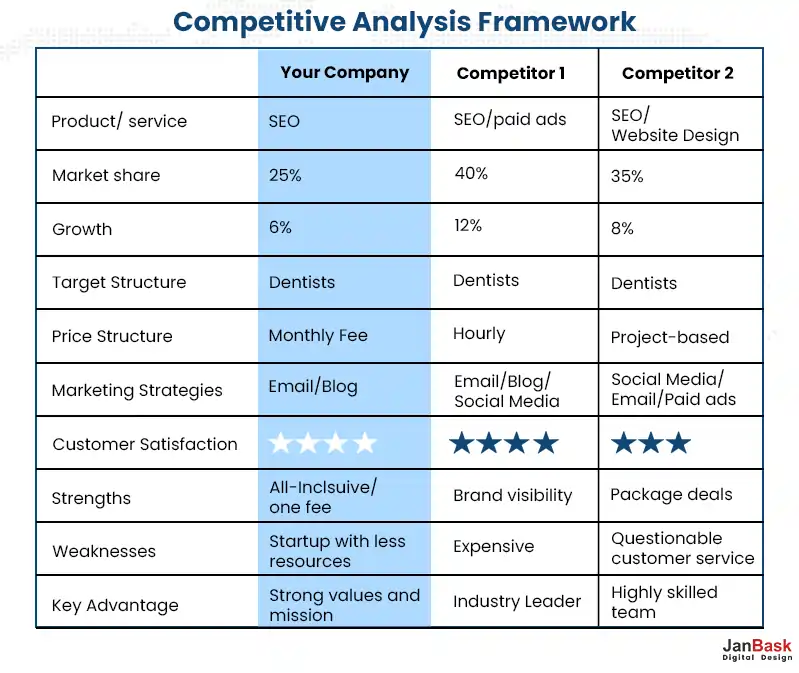
With countless websites and online platforms vying for attention, it's important to understand what your competitors are doing and how you can stand out. This is where web design competitive analysis comes in. By thoroughly analyzing your competitors' websites, you can gain valuable insights into their strengths and weakness and use that knowledge to improve your web design and online strategy.
In this step-by-step guide, we'll take a deep dive into the world of web design competitive analysis. We'll cover everything from identifying your competitors and defining your goals to analyzing their website design, content, and user experience. You'll learn how to use various tools and techniques to gather data and insights and how to use that information to create a website that sets you apart from the competition.
Whether you're a seasoned web designer or just starting out, this guide will provide the tools and knowledge you need to perform a comprehensive competitive web design analysis and create a website that stands out in a crowded online marketplace. So, let's dive in!

Looking for Competitive Web Design Analysis?
Competitive analysis in web design is examining and evaluating your competitors' websites to gain insights into their strengths, weaknesses, and overall online strategy. This competitive analysis in web design aims to identify what your competitors are doing well and where they may be falling short so that you can use that information to improve your website design and online presence.
Competitive analysis in web design typically involves examining various aspects of a competitor's website, including its design, content, user experience, and SEO strategy. Performing a web design competitive analysis allows you to comprehensively understand your competitors' operations and pinpoint areas where you can outperform them. This competitive research in web design also allows you to stay up-to-date with industry trends and maintain a high product quality that meets or exceeds industry standards.
Competitive analysis in web design provides several benefits for businesses seeking to improve their online presence and outperform their competition. Here are some of the key benefits of performing a competitor website analysis:
Identify strengths and weaknesses: By analyzing the websites of your competitors, you can identify their strengths and weaknesses in terms of design, content, user experience, and search engine optimization. This information can be used to improve your own website and online strategy and gain a competitive advantage.
Learn from their successes: By examining what your competitors are doing well, you can learn from them and apply those insights to your website and online strategy. This can help you improve your website's design, content, and user experience and attract more website visitors.
Differentiate your brand: By understanding what sets your competitors apart, you can find ways to differentiate your own brand and stand out in a crowded online marketplace. This can help you attract more website visitors and increase brand awareness.
Stay up-to-date with industry trends: A competitive analysis in web design allows you to stay abreast of the latest trends in your industry and ensure that your website and online strategy are current and relevant. This can help you maintain a competitive edge and attract more website visitors.
Improve search engine visibility: By analyzing your competitors' optimization strategies, you can identify opportunities to improve your website's search engine ranking and visibility. This can help you attract organic traffic to your website and increase your online presence.
You can also reach out to JanBask for help. Our company offers top-notch web design services to help businesses create visually stunning and user-friendly websites.
In the world of business, competition is a fact of life. No matter what industry you're in, other businesses will always be vying for the same customers and market share. This is where competitive research in web design comes in - it is a critical component of competitive research in web design that enables businesses to understand their competitors better and make informed decisions about their own marketing and sales strategies.
Here are some of the key reasons why competitive analysis in web design:
Identify market trends and opportunities: By analyzing your competitors' products, pricing strategies, and marketing tactics, you can gain insights into market trends and identify opportunities that your business may be missing out on. This can help you stay ahead of the curve and capitalize on emerging trends.
Stay relevant and competitive: In today's fast-paced business environment, staying relevant and competitive is essential. Competitive analysis in web design allows you to keep a finger on the pulse of what your competition is doing and adapt your own marketing and sales strategies accordingly. This can help you stay ahead of the curve and remain competitive in your industry.
Understand customer behavior: By analyzing your competitors' customer base, you can gain insights into customer behavior, preferences, and buying habits. This information can help you better understand your own target market and tailor your content marketing messages to resonate with them.
Identify strengths and weaknesses: Competitive analysis in web design allows you to identify your competitors' strengths and weaknesses in products, pricing, marketing, and customer service. This information can help you position your business more effectively and highlight your unique selling points.
Enhance brand reputation: By analyzing your competitors' brand reputation and customer satisfaction levels, you can identify areas where your business may fall short and take steps to improve your reputation and customer satisfaction levels.
When conducting a competitor analysis, it's important to identify direct and indirect competitors. Direct competitors are businesses that offer similar products or services to your own and target the same customers. Indirect competitors, on the other hand, may offer different products or services but still compete for the same customer base. Here's how to identify both types of competitors:

By identifying both direct and indirect competitors, you can gain a comprehensive understanding of the competitive landscape in your industry. This information can help you develop a more effective marketing and sales strategy and stay ahead of the competition.
If you're looking for exceptional website design services, our team of experts can create a captivating online presence that reflects your brand's identity.
Performing an effective competitive analysis in web design can provide valuable insights into your industry, your competitors, and your own business. Here are some steps you can take to perform an effective analysis:

Before starting your competitive analysis in web design, it's important to define your goals. What do you want to achieve by analyzing your competitors' websites? Are you looking to improve your website's performance, identify new marketing opportunities, or better understand your industry? Clearly defining your goals will help you focus your competitive analysis in web design and maximize your efforts.
Once you've set your goals, it's time to identify your competitors. Look for businesses that offer similar products or services to your own and target the same audience. You can use search engines, industry directories, and social media platforms to identify your competitors. Once you've identified your competitors, analyze their target segment to understand their customers better.
The next step is to analyze your competitors' websites. Look at their content, design, and user experience. Identify what sets their website apart and what areas they may lack. Conduct a content/SEO gap analysis to identify keywords, content, or optimization strategies that your competitors are using, but you are not. This competitive research in web design will help you identify areas where you can improve your website and gain a competitive advantage.
Analyze your competitors' positioning in the market. Determine their strengths and weaknesses and see how they position themselves relative to your business. This analysis will help you understand what makes your competitors unique and what differentiates them from your business.
Once you've identified your competitors, analyze their product features in-depth. Explore their websites to understand the functionalities, unique selling points, and key features they highlight. Compare how your product stacks up against theirs regarding quality, innovation, pricing, and value proposition. Identify areas where your product excels and areas where improvements can be made to gain a competitive edge.
Examine how your competitors market their products or services on their websites. Look for their messaging, brand positioning, and unique value propositions. Analyze their content strategies, including blog posts, videos, case studies, or testimonials, to understand how they engage with their audience.
Consider their use of social media platforms, email marketing, or other advertising channels. Identify what resonates with their target audience and evaluate how your own marketing efforts compare. Assess their engagement levels, follower growth, and customer interactions on Facebook, Twitter, Instagram, or LinkedIn platforms. Analyze customer reviews and ratings on review sites or forums to understand their reputation and customer satisfaction.
To gain a deeper understanding of your competitors and their customers, consider reaching out to their customers for feedback. You can use online surveys or focus groups to gather information on what customers like and dislike about their experiences with your competitors. This information can help you identify areas where your competitors are excelling and where they may be falling short.
Understanding your position in the market landscape is crucial for effective competitor analysis. Determine your target market, including your customers' demographics, preferences, and needs. Then, identify your unique value proposition and how it differentiates you from your competitors. Analyze your brand positioning, pricing strategy, and overall market share. By understanding your position, you can better identify where your competitors stand and how they appeal to the market. This web design competitive analysis allows you to find opportunities to differentiate yourself and strengthen your competitive advantage.
The next step is to analyze your competitors' website performance and user experience. This includes examining how quickly their website loads, how easy it is to navigate, and how intuitive their interface is. You should also examine their website's conversion funnel to see how effectively their website converts visitors into customers. This analysis can help you identify ways to improve your own website's performance and user experience.
Run a functional investigation to assess the functionality of your competitors' website. This involves examining their website's features, tools, and technology. Identify what features or tools they are using that you are not and determine how effective they are at meeting their customers' needs. This web design competitive analysis can help you identify ways to improve your own website's functionality and keep up with the latest technology trends in your industry.
Look for updates in product offerings, new features, or changes in pricing strategies. Stay informed about the latest industry news and innovations. By staying up-to-date, you can adapt your own web design and marketing strategies to remain competitive and meet evolving customer demands.
One aspect of your competitors' websites that you should pay attention to is the technology stack they use. Understanding the software and tools they are using to build and maintain their website can provide valuable insights into their overall digital strategy. For example, if you find that your competitors are using a particular CMS or e-commerce platform, you may want to consider using the same platform to stay competitive.

A SWOT analysis (Strengths, Weaknesses, Opportunities, and Threats) is a valuable framework for evaluating your competitors. Start by identifying their strengths, such as unique features, strong brand recognition, or a large customer base. Analyze their weaknesses, such as gaps in their product offerings or poor customer service.
Look for opportunities they may be capitalizing on, such as emerging market trends or untapped customer segments. Finally, assess the threats they pose, such as aggressive marketing campaigns or innovative product developments. By conducting a comprehensive SWOT analysis, you can gain valuable insights into your competitors' positions in the market.
Once you have gathered all the data from your analysis, it's important to integrate your findings into your own digital strategy. Use the insights you gained from analyzing your competitors' websites to make informed decisions about how to improve your own website and digital marketing efforts. For example, if you identified a gap in content on your competitor's website, you may want to create similar content to fill that gap and attract more customers.
Our web designing services encompass everything from conceptualizing unique designs to optimizing user experience, ensuring your website stands out from the competition.

Picture this: You're part of a dynamic marketing startup specializing in providing top-notch SEO services exclusively for lawyers. Since it's a niche industry with just a handful of competitors, you realize the importance of conducting a web design competitive analysis to gain an edge. So, let's dive into the exciting steps of your competitor website analysis journey!
Step 1: Embark on a Google adventure to assemble a comprehensive list of your competitors. Uncover those lawyer SEO wizards who are vying for the top spot in the industry.
Step 2: Equip yourself with powerful SEO analysis tools like Ahrefs, but don't forget the true treasure lies within your competitors' websites.
Step 3: Delve deep into their virtual domains, extracting invaluable insights into their service offerings and cunning marketing strategies.
Step 4: Uncover the secret tactics that make them shine in the digital realm.
Step 5: Shift the spotlight back onto your own remarkable startup. Conduct a SWOT analysis, an engaging exploration that showcases your strategic goals while highlighting your company's strengths and weaknesses. It's a visual feast that provides a clear roadmap for success.
Step 6: With your SWOT analysis complete, it's time to create a captivating graph that illustrates the captivating market landscape. As you study it closely, a revelation dawns upon you: there are two companies reigning supreme in customer satisfaction and market presence. But fear not, for you've got a secret weapon up your sleeve.
Armed with this insightful data, you devise a unique and ingenious strategy. Rather than following in the footsteps of your competitors, who target lawyers nationwide, you unleash the power of localization.
Picture this: you focus your marketing efforts on one specific region, state, or city, establishing yourself as the go-to SEO expert for lawyers in that area. Once your reputation and influence soar, you'll boldly expand your reach, conquering new territories one smile at a time.
So, with a comprehensive table brimming with invaluable insights, you embark on an exciting journey armed with a localization strategy that will set you apart from the competition. Get ready to rewrite the rules of lawyer SEO and become the industry's unrivaled champion!

We understand that it can get overwhelming for brands to do such deep competitive analysis. But fear not because JanBask Digital Design is here to help. With our comprehensive website designing services, we can transform your digital vision into a reality, crafting an engaging and seamless online platform for your business.
Developing a winning web design strategy is crucial for businesses to create a visually appealing, user-friendly, and effective website. Here are some key steps to help you develop a winning web design strategy:
By following these steps and staying updated with industry trends, you can develop a winning web design strategy that creates a positive user experience, drives engagement, and helps you achieve your business objectives.
By following this step-by-step guide to performing a web design competitive analysis, businesses can gain valuable insights into their competition's strategies and identify areas for improvement in their own web design strategy. From setting goals and identifying target segments to analyzing content and SEO strategies, conducting customer interviews, and running functional investigations, businesses can develop a comprehensive understanding of their competition and develop winning web design strategies.
By integrating the findings and continuously monitoring website performance and user feedback, businesses can stay ahead of the curve and achieve their business objectives. With a well-executed web design competitive analysis, businesses can create visually appealing, user-friendly, and effective websites that resonate with their target audience and drive business growth.
Experience the difference with our professional website design service, where we combine creativity and technical expertise to deliver visually striking websites that drive results.
Interested in our Web Design & Development Services?

1. Why is web design competitive analysis important?
Web design competitive analysis is important in web design because it helps you understand your competitors' strategies, strengths, and weaknesses. It enables you to identify opportunities to differentiate your website, improve user experience, and stay ahead of industry trends.
2. How do I identify my direct and indirect competitors?
To identify your direct competitors, look for businesses that offer similar products or services to yours and target the same audience. Indirect competitors can be identified by considering substitute products or services that may compete for the same customer base.
3. What tools can I use to analyze my competitors' websites?
There are various tools available for analyzing competitors' websites, such as SEMrush, Moz, Ahrefs, and SimilarWeb. These tools provide insights into competitors' traffic, keywords, backlinks, and more.
4. What factors should I consider when analyzing my competitors' content and SEO strategies?
When analyzing content and SEO strategies, consider factors like keyword usage, content quality, relevancy, backlink profile, on-page optimization, user engagement metrics, and social media presence.
5. How can I conduct a content/SEO gap analysis to identify areas of improvement?
To conduct a content/SEO gap analysis, compare your website's content, keyword rankings, and optimization efforts with those of your competitors. Identify areas where your competitors have an advantage and develop strategies to bridge the gaps.
6. Is it necessary to interview my competitors' customers during the analysis?
While not mandatory, interviewing your competitors' customers can provide valuable insights into their experiences, preferences, and satisfaction levels. It helps you understand what your competitors are doing right or wrong from a customer perspective.
7. What aspects of my competitors' websites should I focus on to assess their performance and user experience?
Focus on factors like website speed, mobile responsiveness, navigation ease, call-to-action placement, visual design, content organization, and overall user flow to assess competitors' website performance and user experience.
8. How can I run a functional investigation to evaluate the functionality of my competitors' websites?
Run a functional investigation by exploring your competitors' websites and testing their features, forms, search functionality, shopping carts, payment gateways, and any interactive elements to gauge their functionality and user-friendliness.
9. How do I integrate the findings from my competitor analysis into my own web design strategy?
Integrate the findings by identifying areas where you can improve your website's design, content, user experience, and SEO based on the strengths and weaknesses identified in your competitor analysis. Implement changes that align with your brand and target audience.
10. How often should I perform a competitor website analysis to stay up-to-date with industry trends?
Perform competitor website analysis periodically, depending on the pace of your industry's changes and developments. Typically, conducting an analysis every six months to a year can help you stay informed about the latest trends and keep your website competitive.
J
This step-by-step guide on web design competitive analysis is a game-changer! It’s exactly what I needed to gain an edge in the industry. Thanks for the valuable insights!
E
I’ve always struggled with identifying my competitors and analyzing their strategies. This guide breaks it down perfectly, making it so much easier to perform a thorough analysis. Kudos to the author!
R
The section on conducting market research really opened my eyes to the importance of understanding the competitive landscape. I can’t wait to apply these techniques and stay one step ahead of my rivals.
K
Comparing product features is such a crucial aspect of web design competitive analysis. This guide provides practical tips on how to effectively analyze and benchmark against competitors. Super helpful!
A
I never realized the significance of analyzing competitors’ marketing strategies until I read this guide. It’s amazing how much you can learn by dissecting their content, SEO, and social media efforts. Mind blown!
T
The emphasis on user experience and website performance in this guide is spot on. It’s essential to understand how your competitors are delivering a seamless online experience. Great insights!
B
Running a functional investigation is a brilliant idea! It’s not just about appearances; it’s about ensuring your website functions flawlessly. This guide goes above and beyond in guiding us through the process.
C
The step about integrating your findings is crucial. It’s not enough to gather data; you need to translate it into actionable strategies. This guide offers practical advice on making the most of your analysis.
F
I appreciate how this guide provides real-life examples and case studies. It helps illustrate the concepts and makes them more relatable. Well done!
Z
Web design competitive analysis can be overwhelming, but this guide breaks it down into manageable steps. It’s a comprehensive resource that I’ll keep coming back to for reference. Thank you for demystifying the process!